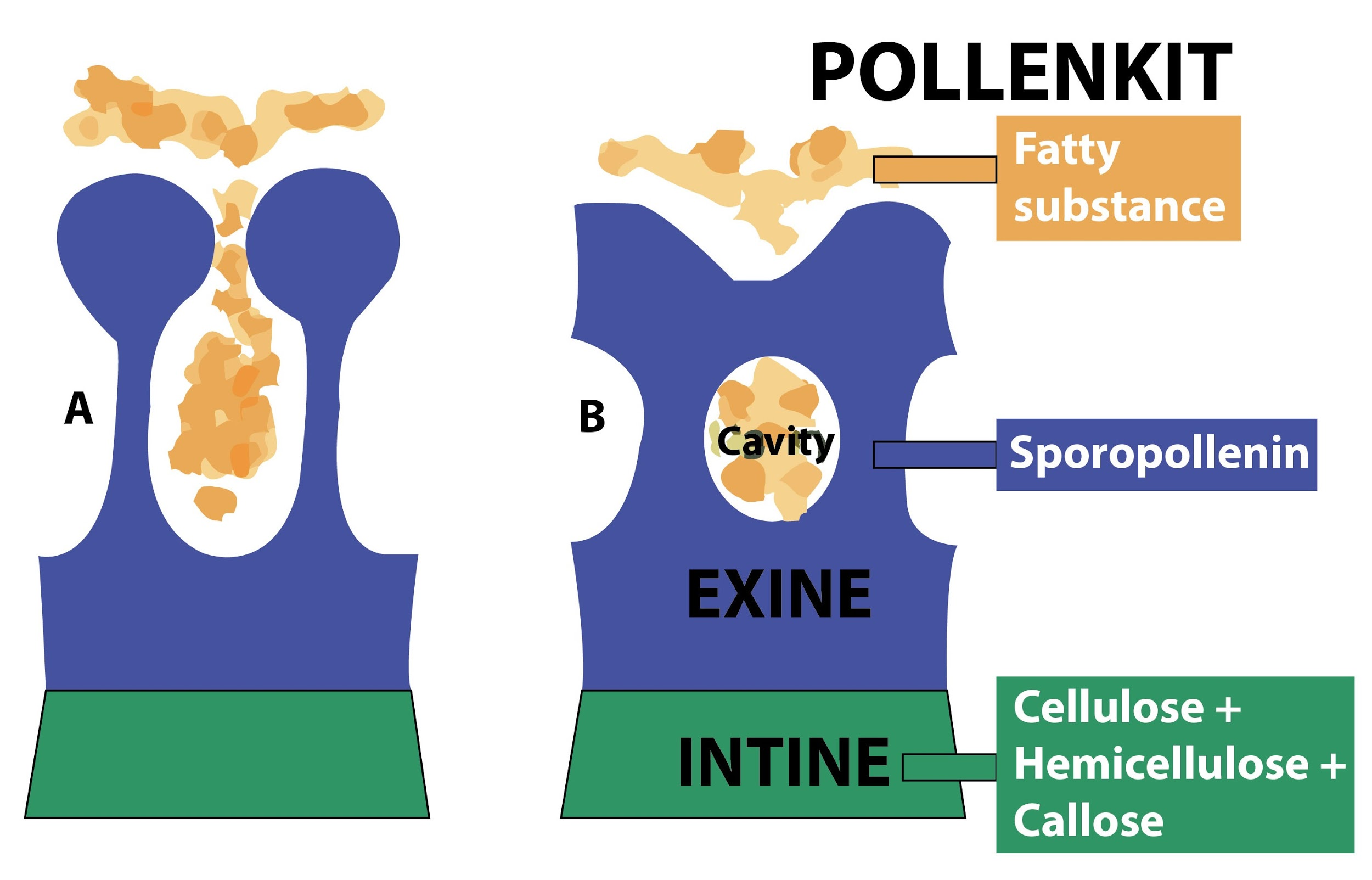
Pollenkitt is formed from
(a) Endothecium
(b) Middle layers
(c) Microspore mother cell
(d) Tapetum
Answer
553.2k+ views
Hint: This is found within the anther of flowering plants, and it is a specialized layer of nutritive cells. Within the anther, these cells are located between the sporogenous tissue and the wall.
Complete answer:
Pollenkitt is formed from the tapetum that surrounds the developing pollen mother cells and microspores. It is responsible for supplying nutrition and enzymes required for microsporogenesis and pollen maturation.
Additional Information:
- Pollenkitt is a very common adhesive- like material present around pollen grains as a yellow covering in almost all the plant belongs to the angiosperms. These pollens are generally pollinated by the animals.

- We can say that pollenkitt is found mainly in animal pollinator plants because they are very sticky.
- It is like an oily layer that provides stickiness and specific odor to the pollen and also helps in insect pollination.
- Pollenkitt is a protective envelope- like structure and acts like an adhering agent. - It also helps in pollination.
- The pollen from many wind- pollinated plants, such as grass, is much drier and not nearly sticky this is because they can be easily carried by the winds.
- The materials required for the formation of pollenkitt are chiefly contributed by the tapetal cells i.e. tapetum.
- Tapetum is very much important for the nutrition and development of pollen grains.
- Cells of tapetum are usually bigger and have more than one nucleus per cell.
- The nucleus of the tapetal cells also divide during the mitotic division of the sporogenous cells. This will help in providing nutrients and regulatory molecules to the forming pollen grains.
So, the correct answer is ‘(d) Tapetum'.
Note:
- The pollenkitt consists of lipids and carotenoids and is formed by tapetum.
- Pollenkitt is a protective envelope- like structure and acts like an adhering agent. - It also helps in pollination.
- Tapetum is also a source of precursors for the pollen coat.
Complete answer:
Pollenkitt is formed from the tapetum that surrounds the developing pollen mother cells and microspores. It is responsible for supplying nutrition and enzymes required for microsporogenesis and pollen maturation.
Additional Information:
- Pollenkitt is a very common adhesive- like material present around pollen grains as a yellow covering in almost all the plant belongs to the angiosperms. These pollens are generally pollinated by the animals.

- We can say that pollenkitt is found mainly in animal pollinator plants because they are very sticky.
- It is like an oily layer that provides stickiness and specific odor to the pollen and also helps in insect pollination.
- Pollenkitt is a protective envelope- like structure and acts like an adhering agent. - It also helps in pollination.
- The pollen from many wind- pollinated plants, such as grass, is much drier and not nearly sticky this is because they can be easily carried by the winds.
- The materials required for the formation of pollenkitt are chiefly contributed by the tapetal cells i.e. tapetum.
- Tapetum is very much important for the nutrition and development of pollen grains.
- Cells of tapetum are usually bigger and have more than one nucleus per cell.
- The nucleus of the tapetal cells also divide during the mitotic division of the sporogenous cells. This will help in providing nutrients and regulatory molecules to the forming pollen grains.
So, the correct answer is ‘(d) Tapetum'.
Note:
- The pollenkitt consists of lipids and carotenoids and is formed by tapetum.
- Pollenkitt is a protective envelope- like structure and acts like an adhering agent. - It also helps in pollination.
- Tapetum is also a source of precursors for the pollen coat.
Recently Updated Pages
Master Class 12 Business Studies: Engaging Questions & Answers for Success

Master Class 12 Economics: Engaging Questions & Answers for Success

Master Class 12 English: Engaging Questions & Answers for Success

Master Class 12 Maths: Engaging Questions & Answers for Success

Master Class 12 Social Science: Engaging Questions & Answers for Success

Master Class 12 Chemistry: Engaging Questions & Answers for Success

Trending doubts
What are the major means of transport Explain each class 12 social science CBSE

Which are the Top 10 Largest Countries of the World?

Draw a labelled sketch of the human eye class 12 physics CBSE

Explain sex determination in humans with line diag class 12 biology CBSE

The pH of the pancreatic juice is A 64 B 86 C 120 D class 12 biology CBSE

Explain sex determination in humans with the help of class 12 biology CBSE




